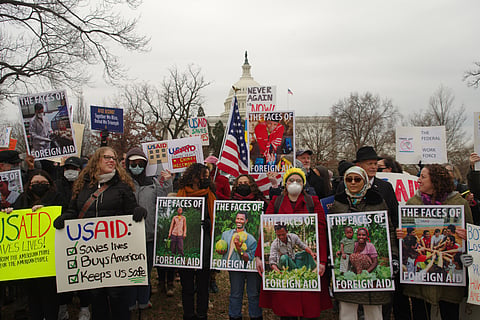Weekend Reads | Where Does U.S. Foreign Aid Go?
In the aftermath of the Trump administration's attempt to shut down the U.S. Agency for International Development (USAID), it's worth taking a few minutes to understand the nation's foreign aid: how much we spend, what we spend it on, and who receives the money. This weekend's read is a report from Pew Research Center that does just that.
In 2023, the most recent year for which there is a complete accounting, the United States spent $71.9 billion on foreign aid, 1.2% of the entire federal budget of $6.1 trillion. That's a big increase from the $24.6 million (in inflation-adjusted dollars) spent in 2001, and even a pretty sizable jump up from the roughly $53 million spent in 2022 due to the addition of aid to Ukraine. Over the past 24 years, foreign aid has landed somewhere between 0.7% and 1.4% of the nation's budget each year — a lot of money, but hardly the lion's share. If one were to go back as far as the 1960s, during the height of the Cold War, foreign aid was as high as 4.7% of the budget, but those days are long behind us. Nevertheless, according to the United Nations, the U.S. is the largest aid donor in the world and contributes about 40% of all aid across the globe.
As for what it was used for, Pew lists four categories that collectively comprise about 85% of the spending: economic development (27%), humanitarian assistance (21.7%), health (22.3%), and "peace and security" (14.2%). Smaller slices were devoted to education (2%), promoting democracy and human rights (3.2%), and the environment (1.9%).
The United States directed foreign aid to 177 different countries, with Ukraine being the big one ($16.6 billion) and Israel the second-largest ($3.3 billion). Chunks also went to several other nations in the Middle East and on the African continent, including Ethiopia, Jordan, Egypt, Afghanistan, Somalia, Nigeria, Congo, and Syria.
Three-fifths of the aid — about $43.8 billion — was distributed by USAID, the agency that the Trump administration is trying to shut down, or at least consolidate into the State Department (despite Congress' mandate that it be a separate, independent agency free of political whims). The State Department issued another 30% ($21.3 billion). The rest went through 19 separate federal agencies, including the Treasury Department, Health and Human Services, and the Millennium Challenge Corporation.
Military assistance only accounted for $8.28 billion, or 11.4% of the total foreign aid, though the Pew report points out that the United States also provides military assistance to other nations in other forms than direct foreign aid payments and gifts of weapons.
Pew, being a survey organization, also included some reporting on Americans' views on foreign aid. As a population, we are largely split on the topic: 35% want to increase spending, 33% want to keep it the same, and 28% want to decrease it. Pew found four uses that are broadly supported: protecting the U.S. from terrorist attacks; reducing the flow of illegal drugs; preventing the spread of weapons of mass destruction; and reducing the spread of infectious diseases. Only about one-quarter of those surveyed said promoting and defending human rights in other countries should be a priority for foreign aid, and even fewer (about 1 in 6) thought promoting democracy in other nations should be a priority.
A key question that the Pew report doesn't answer is how effective foreign aid is as a tool for achieving the goals listed above, and whether the "return on investment" is worth it. One can imagine that trying to answer those questions is very difficult (though certainly some people are proposing answers), but at the same time, it seems strange that we're having a fervent national debate about foreign aid without good answers.
Help keep BIPOC-led, community-powered journalism free — become a Rainmaker today.


